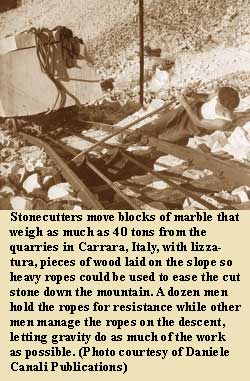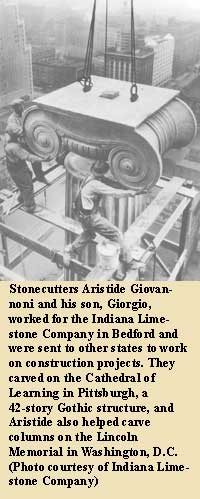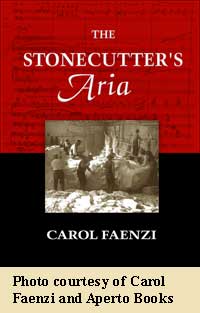Fact and fiction bring lives of Catholic stonecutters in the archdiocese to life
By Mary Ann Wyand
 Have you ever admired historic and ornate limestone buildings gracing the downtown area of a city then wondered who carved the beautiful columns, ornamental arches, lifelike statues, intricate flowers and decorative leaves that define their architecture?
Have you ever admired historic and ornate limestone buildings gracing the downtown area of a city then wondered who carved the beautiful columns, ornamental arches, lifelike statues, intricate flowers and decorative leaves that define their architecture?
Then perhaps you know that these elegant and timeless structures created during the 1920s and 1930s were carved with blood, sweat, tears and pride by immigrant artisans who labored for many hours to bring beauty from bedrock.
But while their artistry will survive for centuries, most of their life stories have already faded into obscurity, remembered only by loved ones who shared memories of their ancestors with new generations.
Four years ago, author Carol Faenzi of New York embarked on a life-changing journey into her Italian family’s unique heritage and history in Carrara, Italy, and finally in Indianapolis and Bedford. Then she skillfully crafted their memorable experiences into a book with words that flow as smoothly as raindrops down the face of a chiseled stone façade.
The amazing result is The Stonecutter’s Aria, a fictionalized account of “La Famiglia” dating back to 1891 in Carrara, Italy, where her male ancestors quarried and carved the beautiful marble as they sang arias from Italian operas. They worked the same mountains where Michelangelo selected the stones to sculpt “The Pieta” and “David.”
But it was hard and dangerous work cutting stone out of the mountains, and tales of the riches to be found in America convinced Faenzi’s great-grandparents, like millions of others, to sell most of their belongings and book passage to the new world.
Her compelling family narrative is a story of the faith, hope and love that inspired her ancestors to bid farewell to their beloved home in search of prosperity in America.
“I received insights about my own life as I was writing their story,” Faenzi said. “Their bravery and courage showed me I could change my own life. It led me back to my faith and a newfound purpose.”
 Readers will follow stonecutter Aristide Giovannoni during the early years of the 20th century amid turbulent times of labor wars, the Depression, racism and anarchy. They will marvel at Aristide and his wife, Ione Brizzolari, who were faithful during a
10-year separation while he worked long hours carving stone in several U.S. cities to forge a new life and save enough money to bring his family to America.
Readers will follow stonecutter Aristide Giovannoni during the early years of the 20th century amid turbulent times of labor wars, the Depression, racism and anarchy. They will marvel at Aristide and his wife, Ione Brizzolari, who were faithful during a
10-year separation while he worked long hours carving stone in several U.S. cities to forge a new life and save enough money to bring his family to America.
When Aristide is finally reunited with his family at the New York harbor after their perilous ocean crossing, his joy is so tangible that readers will truly understand the hardships and sacrifices faced by families immigrating to a new country.
Aristide takes his family to begin a new life in the heat and humidity of Mont-gomery, Ala., but racial and ethnic
violence against Negroes and Catholics by the Ku Klux Klan in the Old South causes them to live in constant fear.
Readers will share Aristide’s relief and joy when he finds work with the Indiana Limestone Company at a stone quarry in Bedford and moves his family to Indianapolis in 1924.
During the Depression era, Aristide is called upon to use his Gothic architectural skills when he and his son, Giorgio, are sent to work on the chapel at Duke University, the Cathedral of Learning at Pittsburgh and the National Archives Buildings in Washington, D.C., among others.
Archdiocesan Catholics in particular will delight in reading Faenzi’s descriptions of their happy life as they make a home for their growing family in the Italian neighborhood of historic Holy Rosary Parish.
Msgr. Joseph F. Schaedel, vicar general and pastor of Holy Rosary Parish, said recently that he “was surprised and very pleased to see the Italian parish of Indianapolis, La Chiesa del Santo Rosario, portrayed accurately in The Stonecutter’s Aria.”
He said “Holy Rosary Parish has played and continues to play a prominent role in the traditionally Italian neighborhood that the author describes. Some of the characters in the story also were characters in the early days in the life of Holy Rosary Church.”
Faenzi’s vivid accounts of construction of the brick church—completed in 1925 with the grueling effort of lifting six huge bells to the top of the two towers—and Franciscan Father Mario Priori’s loving pastoral care of his Italian parishioners will bring smiles to readers, especially those who have participated in Masses there and enjoyed the festivities at the parish’s annual Italian Street Festival.
“Where there is love, there is God,” Father Priori tells Aristide and Ione’s grown daughter, Olga, when she tearfully confesses her guilt about falling in love again so soon after the death of her fiancé. The priest assures Olga that God wants her to be happy so she marries the love of her life, Ottavio Faenzi, who finds work as a chef at the Columbia Club in Indianapolis and embarks on a 40-year career there.
Faenzi said writing the book was a spiritual experience for her and a gesture of love for the ancestors she was so grateful to learn about during her extended visits to Carrara, Italy, and Indianapolis.
 In the process, she discovered anew that art and music bring beauty to life and help people smile in the midst of their struggles.
In the process, she discovered anew that art and music bring beauty to life and help people smile in the midst of their struggles.
“Aria” means “air” in Italian, Faenzi said. “There are two opera houses in Carrara, and the love of opera was as important to them as their marble. Aristide was always singing. I thought about what his life was like in America for 10 years without his family. His music saved him.”
Faenzi said she felt “a huge responsibility” to be true to her family’s ideals and experiences while creatively expanding on the facts she had gathered from their life stories.
“By going to Italy and giving myself time there, the story unfolded for me,” she said. “At times, I felt inadequate for the job. But when I let go of the pressure, the idea came to me to let their voices speak for themselves.”
Her book is written in first-person style and the unique form of an opera program.
Faenzi said she took a sabbatical from her high-powered, fast-paced career in New York to research her ancestors’ lives. She moved from Indianapolis in her early 30s, but considers it her home and chose the Columbia Club to launch the release of her book in September.
“I have a historical connection, a family connection, with Holy Rosary Parish,” she said. “It’s comforting to come home and go to Mass there with my Aunt Joann [Wilson].”
Faenzi’s book was recently selected as “Reviewer’s Choice for Fiction” by the Midwest Book Review. Readers have said her story would make a great movie.
“I started out with an idea to preserve my family’s history,” she said, “and then it turned into something more profound. It’s about our need to belong, and it is my desire to motivate readers to discover their own family history [and] find ways to preserve their heritage for future generations.”
(To order The Stonecutter’s Aria, call 800-345-6665. Carol Faenzi’s book sells for $16.95 and can be purchased at the History Market at the Indiana Historical Society in Indianapolis, ordered through any local bookstore or purchased online at www.thestonecuttersaria.com.) †


